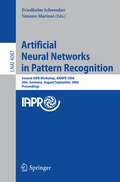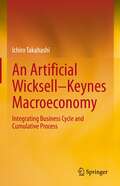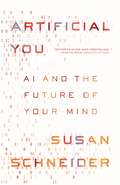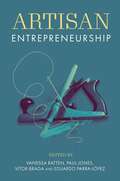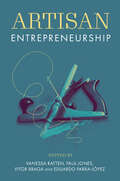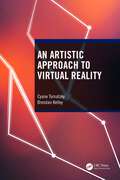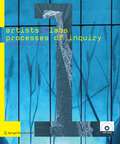- Table View
- List View
Artificial Neural Networks in Pattern Recognition: 10th IAPR TC3 Workshop, ANNPR 2022, Dubai, United Arab Emirates, November 24–26, 2022, Proceedings (Lecture Notes in Computer Science #13739)
by Neamat El Gayar Edmondo Trentin Mirco Ravanelli Hazem AbbasThis book constitutes the refereed proceedings of the 10th IAPR TC3 International Workshop on Artificial Neural Networks in Pattern Recognition, ANNPR 2022, held in Dubai, UAE, in November 2022. The 16 revised full papers presented were carefully reviewed and selected from 24 submissions. The conference presents papers on subject such as pattern recognition and machine learning based on artificial neural networks.
Artificial Neural Networks in Pattern Recognition: 5th INNS IAPR TC 3 GIRPR Workshop, ANNPR 2012, Trento, Italy, September 17-19, 2012, Proceedings (Lecture Notes in Computer Science #7477)
by Nadia Mana Friedhelm Schwenker Edmondo TrentinThis book constitutes the refereed proceedings of the 5th INNS IAPR TC3 GIRPR International Workshop on Artificial Neural Networks in Pattern Recognition, ANNPR 2012, held in Trento, Italy, in September 2012. The 21 revised full papers presented were carefully reviewed and selected for inclusion in this volume. They cover a large range of topics in the field of neural network- and machine learning-based pattern recognition presenting and discussing the latest research, results, and ideas in these areas.
Artificial Neural Networks in Pattern Recognition: 8th IAPR TC3 Workshop, ANNPR 2018, Siena, Italy, September 19–21, 2018, Proceedings (Lecture Notes in Computer Science #11081)
by Luca Pancioni Friedhelm Schwenker Edmondo TrentinThis book constitutes the refereed proceedings of the 8th IAPR TC3 International Workshop on Artificial Neural Networks in Pattern Recognition, ANNPR 2018, held in Siena, Italy, in September 2018.The 29 revised full papers presented together with 2 invited papers were carefully reviewed and selected from 35 submissions. The papers present and discuss the latest research in all areas of neural network- and machine learning-based pattern recognition. They are organized in two sections: learning algorithms and architectures, and applications. Chapter "Bounded Rational Decision-Making with Adaptive Neural Network Priors" is available open access under a Creative Commons Attribution 4.0 International License via link.springer.com.
Artificial Neural Networks in Pattern Recognition: Third IAPR TC3 Workshop, ANNPR 2008 Paris, France, July 2-4, 2008, Proceedings (Lecture Notes in Computer Science #5064)
by Lionel Prevost Simone Marinai Friedhelm SchwenkerArtificial Neural Networks in Pattern Recognition: 7th IAPR TC3 Workshop, ANNPR 2016, Ulm, Germany, September 28–30, 2016, Proceedings (Lecture Notes in Computer Science #9896)
by Friedhelm Schwenker Hazem M. Abbas Neamat El Gayar Edmondo TrentinThis book constitutes the refereed proceedings of the 7th IAPR TC3 International Workshop on Artificial Neural Networks in Pattern Recognition, ANNPR 2016, held in Ulm, Germany, in September 2016. The 25 revised full papers presented together with 2 invited papers were carefully reviewed and selected from 32 submissions for inclusion in this volume. The workshop will act as a major forum for international researchers and practitioners working in all areas of neural network- and machine learning-based pattern recognition to present and discuss the latest research, results, and ideas in these areas.
Artificial Neural Networks in Pattern Recognition: 4th IAPR TC3 Workshop, ANNPR 2010, Cairo, Egypt, April 11-13, 2010, Proceedings (Lecture Notes in Computer Science #5998)
by Friedhelm Schwenker Neamat El GayarArtificial Neural Networks in Pattern Recognition: Second IAPR Workshop, ANNPR 2006, Ulm, Germany, August 31-September 2, 2006, Proceedings (Lecture Notes in Computer Science #4087)
by Friedhelm Schwenker Simone MarinaiThis book constitutes the refereed proceedings of the Second IAPR Workshop on Artificial Neural Networks in Pattern Recognition, ANNPR 2006, held in Ulm, Germany in August/September 2006. The 26 revised papers presented were carefully reviewed and selected from 49 submissions. The papers are organized in topical sections on unsupervised learning, semi-supervised learning, supervised learning, support vector learning, multiple classifier systems, visual object recognition, and data mining in bioinformatics.
Artificial Neural Networks in Pattern Recognition: 9th IAPR TC3 Workshop, ANNPR 2020, Winterthur, Switzerland, September 2–4, 2020, Proceedings (Lecture Notes in Computer Science #12294)
by Thilo Stadelmann Frank-Peter SchillingThis book constitutes the refereed proceedings of the 9th IAPR TC3 International Workshop on Artificial Neural Networks in Pattern Recognition, ANNPR 2020, held in Winterthur, Switzerland, in September 2020. The conference was held virtually due to the COVID-19 pandemic. The 22 revised full papers presented were carefully reviewed and selected from 34 submissions. The papers present and discuss the latest research in all areas of neural network-and machine learning-based pattern recognition. They are organized in two sections: learning algorithms and architectures, and applications.
Artificial Neural Networks in Vehicular Pollution Modelling (Studies in Computational Intelligence #41)
by Mukesh Khare S.M. Shiva NagendraThis book provides a step-by-step procedure for formulation and development of Artificial Neural Networks based Vehicular pollution models. It takes into account meteorological and traffic aspects. The book will be useful for professionals and researchers working in problems associated with urban air pollution management and control
Artificial Neural Networks with Java: Tools for Building Neural Network Applications
by Igor LivshinUse Java to develop neural network applications in this practical book. After learning the rules involved in neural network processing, you will manually process the first neural network example. This covers the internals of front and back propagation, and facilitates the understanding of the main principles of neural network processing. Artificial Neural Networks with Java also teaches you how to prepare the data to be used in neural network development and suggests various techniques of data preparation for many unconventional tasks. The next big topic discussed in the book is using Java for neural network processing. You will use the Encog Java framework and discover how to do rapid development with Encog, allowing you to create large-scale neural network applications.The book also discusses the inability of neural networks to approximate complex non-continuous functions, and it introduces the micro-batch method that solves this issue. The step-by-step approach includes plenty of examples, diagrams, and screen shots to help you grasp the concepts quickly and easily.What You Will LearnPrepare your data for many different tasksCarry out some unusual neural network tasksCreate neural network to process non-continuous functionsSelect and improve the development model Who This Book Is ForIntermediate machine learning and deep learning developers who are interested in switching to Java.
Artificial Neural Networks with Java: Tools for Building Neural Network Applications
by Igor LivshinDevelop neural network applications using the Java environment. After learning the rules involved in neural network processing, this second edition shows you how to manually process your first neural network example. The book covers the internals of front and back propagation and helps you understand the main principles of neural network processing. You also will learn how to prepare the data to be used in neural network development and you will be able to suggest various techniques of data preparation for many unconventional tasks. This book discusses the practical aspects of using Java for neural network processing. You will know how to use the Encog Java framework for processing large-scale neural network applications. Also covered is the use of neural networks for approximation of non-continuous functions. In addition to using neural networks for regression, this second edition shows you how to use neural networks for computer vision. It focuses on image recognition such as the classification of handwritten digits, input data preparation and conversion, and building the conversion program. And you will learn about topics related to the classification of handwritten digits such as network architecture, program code, programming logic, and execution. The step-by-step approach taken in the book includes plenty of examples, diagrams, and screenshots to help you grasp the concepts quickly and easily.What You Will LearnUse Java for the development of neural network applicationsPrepare data for many different tasksCarry out some unusual neural network processingUse a neural network to process non-continuous functionsDevelop a program that recognizes handwritten digitsWho This Book Is ForIntermediate machine learning and deep learning developers who are interested in switching to Java
Artificial Neural Networks with TensorFlow 2: ANN Architecture Machine Learning Projects
by Poornachandra SarangDevelop machine learning models across various domains. This book offers a single source that provides comprehensive coverage of the capabilities of TensorFlow 2 through the use of realistic, scenario-based projects.After learning what's new in TensorFlow 2, you'll dive right into developing machine learning models through applicable projects. This book covers a wide variety of ANN architectures—starting from working with a simple sequential network to advanced CNN, RNN, LSTM, DCGAN, and so on. A full chapter is devoted to each kind of network and each chapter consists of a full project describing the network architecture used, the theory behind that architecture, what data set is used, the pre-processing of data, model training, testing and performance optimizations, and analysis. This practical approach can either be used from the beginning through to the end or, if you're already familiar with basic ML models, you can dive right into the application that interests you. Line-by-line explanations on major code segments help to fill in the details as you work and the entire project source is available to you online for learning and further experimentation. With Artificial Neural Networks with TensorFlow 2 you'll see just how wide the range of TensorFlow's capabilities are. What You'll LearnDevelop Machine Learning ApplicationsTranslate languages using neural networksCompose images with style transferWho This Book Is ForBeginners, practitioners, and hard-cored developers who want to master machine and deep learning with TensorFlow 2. The reader should have working concepts of ML basics and terminologies.
Artificial Neuronal Networks: Application to Ecology and Evolution (Environmental Science and Engineering)
by Jean-FrançoisGuégan SovanLekIn this book, an easily understandable account of modelling methods with artificial neuronal networks for practical applications in ecology and evolution is provided. Special features include examples of applications using both supervised and unsupervised training, comparative analysis of artificial neural networks and conventional statistical methods, and proposals to deal with poor datasets. Extensive references and a large range of topics make this book a useful guide for ecologists, evolutionary ecologists and population geneticists.
Artificial Organic Networks: Artificial Intelligence Based on Carbon Networks (Studies in Computational Intelligence #521)
by Hiram Ponce-Espinosa Pedro Ponce-Cruz Arturo MolinaThis monograph describes the synthesis and use of biologically-inspired artificial hydrocarbon networks (AHNs) for approximation models associated with machine learning and a novel computational algorithm with which to exploit them. The reader is first introduced to various kinds of algorithms designed to deal with approximation problems and then, via some conventional ideas of organic chemistry, to the creation and characterization of artificial organic networks and AHNs in particular.The advantages of using organic networks are discussed with the rules to be followed to adapt the network to its objectives. Graph theory is used as the basis of the necessary formalism. Simulated and experimental examples of the use of fuzzy logic and genetic algorithms with organic neural networks are presented and a number of modeling problems suitable for treatment by AHNs are described:· approximation;· inference;· clustering;· control;· classification; and· audio-signal filtering.The text finishes with a consideration of directions in which AHNs could be implemented and developed in future. A complete LabVIEW™ toolkit, downloadable from the book’s page at springer.com enables readers to design and implement organic neural networks of their own.The novel approach to creating networks suitable for machine learning systems demonstrated in Artificial Organic Networks will be of interest to academic researchers and graduate students working in areas associated with computational intelligence, intelligent control, systems approximation and complex networks.
Artificial Psychology: Psychological Modeling and Testing of AI Systems
by John Carbone James A. Crowder Shelli FriessThis book explores the subject of artificial psychology and how the field must adapt human neuro-psychological testing techniques to provide adequate cognitive testing of advanced artificial intelligence systems. It shows how classical testing methods will reveal nothing about the cognitive nature of the systems and whether they are learning, reasoning, and evolving correctly; for these systems, the authors outline how testing techniques similar to/adapted from human psychological testing must be adopted, particularly in understanding how the system reacts to failure or relearning something it has learned incorrectly or inferred incorrectly. The authors provide insights into future architectures/capabilities that artificial cognitive systems will possess and how we can evaluate how well they are functioning. It discusses at length the notion of human/AI communication and collaboration and explores such topics as knowledge development, knowledge modeling and ambiguity management, artificial cognition and self-evolution of learning, artificial brain components and cognitive architecture, and artificial psychological modeling.Explores the concepts of Artificial Psychology and Artificial Neuroscience as applied to advanced artificially cognitive systems;Provides insight into the world of cognitive architectures and biologically-based computing designs which will mimic human brain functionality in artificial intelligent systems of the future;Provides description and design of artificial psychological modeling to provide insight into how advanced artificial intelligent systems are learning and evolving;Explores artificial reasoning and inference architectures and the types of modeling and testing that will be required to "trust" an autonomous artificial intelligent systems.
Artificial Superintelligence: A Futuristic Approach
by Roman V. YampolskiyA day does not go by without a news article reporting some amazing breakthrough in artificial intelligence (AI). Many philosophers, futurists, and AI researchers have conjectured that human-level AI will be developed in the next 20 to 200 years. If these predictions are correct, it raises new and sinister issues related to our future in the age of
Artificial Superintelligence: A Futuristic Approach
by Roman V. YampolskiyA day does not go by without a news article reporting some amazing breakthrough in artificial intelligence (AI). Many philosophers, futurists, and AI researchers have conjectured that human-level AI will be developed in the next 20 to 200 years. If these predictions are correct, it raises new and sinister issues related to our future in the age of
An Artificial Wicksell—Keynes Macroeconomy: Integrating Business Cycle and Cumulative Process
by Ichiro TakahashiThis book presents an agent-based macroeconomic model developed on the Keynesian principle of effective demand and the Wicksellian theory of cumulative process. The main purpose of the book is to demystify inherent forces that revive an economy from a long-run downturn. The model has three types of bounded-rational agents: firm, household, and bank. To highlight the autonomous revival mechanisms, the model is assumed to be completely closed and free from any external influences such as changes in management of aggregate demand or supply/demand shocks. The key finding of the book is that diversity of firms is a crucial element in reviving investment activities. While a production sector is represented by a single firm in a conventional model, this model has introduced a large number of heterogeneous firms that confront diverse constraints both at the firm and aggregate levels. The behaviours of these firms may vary despite being exposed to the same aggregate environment. For example, economic downturns usually precipitate a fall in real wages as a response to decreased aggregate demand. Most firms reduce their employment focusing on the reduction in aggregate demand. However, some firms identify a reduction in real wage as a sign of improving profitability hence they may expand employment. This could result in an increased aggregate demand and benefit other firms with further employment. It could even reverse the trend to an upslope, thereby ultimately achieving full of near full employment. This book details further on: (1) the rigidity of prices and wages in a stable economy (2) the fundamental factors to establish a robust and high-performing economy, with the focus on the importance of a stable and equitable macroeconomic environment.
Artificial You: AI and the Future of Your Mind
by Susan SchneiderA sober-minded philosophical exploration of what AI can and cannot achieveHumans may not be Earth’s most intelligent beings for much longer: the world champions of chess, Go, and Jeopardy! are now all AIs. Given the rapid pace of progress in AI, many predict that it could advance to human-level intelligence within the next several decades. From there, it could quickly outpace human intelligence. What do these developments mean for the future of the mind?In Artificial You, Susan Schneider says that it is inevitable that AI will take intelligence in new directions, but urges that it is up to us to carve out a sensible path forward. As AI technology turns inward, reshaping the brain, as well as outward, potentially creating machine minds, it is crucial to beware. Homo sapiens, as mind designers, will be playing with "tools" they do not understand how to use: the self, the mind, and consciousness. Schneider argues that an insufficient grasp of the nature of these entities could undermine the use of AI and brain enhancement technology, bringing about the demise or suffering of conscious beings. To flourish, we must grasp the philosophical issues lying beneath the algorithms.At the heart of her exploration is a sober-minded discussion of what AI can truly achieve: Can robots really be conscious? Can we merge with AI, as tech leaders like Elon Musk and Ray Kurzweil suggest? Is the mind just a program? Examining these thorny issues, Schneider proposes ways we can test for machine consciousness, questions whether consciousness is an unavoidable byproduct of sophisticated intelligence, and considers the overall dangers of creating machine minds.
Artificial You: AI and the Future of Your Mind
by Susan SchneiderA sober-minded philosophical exploration of what AI can and cannot achieveHumans may not be Earth’s most intelligent beings for much longer: the world champions of chess, Go, and Jeopardy! are now all AIs. Given the rapid pace of progress in AI, many predict that it could advance to human-level intelligence within the next several decades. From there, it could quickly outpace human intelligence. What do these developments mean for the future of the mind?In Artificial You, Susan Schneider says that it is inevitable that AI will take intelligence in new directions, but urges that it is up to us to carve out a sensible path forward. As AI technology turns inward, reshaping the brain, as well as outward, potentially creating machine minds, it is crucial to beware. Homo sapiens, as mind designers, will be playing with "tools" they do not understand how to use: the self, the mind, and consciousness. Schneider argues that an insufficient grasp of the nature of these entities could undermine the use of AI and brain enhancement technology, bringing about the demise or suffering of conscious beings. To flourish, we must grasp the philosophical issues lying beneath the algorithms.At the heart of her exploration is a sober-minded discussion of what AI can truly achieve: Can robots really be conscious? Can we merge with AI, as tech leaders like Elon Musk and Ray Kurzweil suggest? Is the mind just a program? Examining these thorny issues, Schneider proposes ways we can test for machine consciousness, questions whether consciousness is an unavoidable byproduct of sophisticated intelligence, and considers the overall dangers of creating machine minds.
Artisan Entrepreneurship
by Vanessa Ratten Paul Jones Vitor Braga Eduardo Parra-LópezIncreased interest in handicrafts has led to more people becoming artisans both as a hobby and a business activity, making Artisan Entrepreneurship a growing phenomenon. This has been particularly relevant during the COVID-19 crisis in which individuals and communities began engaging with more bespoke crafting at home. This book focuses on these practices from different perspectives including the art, cultural and social sectors, thereby highlighting the emerging new types of artisan activity that preserve cultural elements while incorporating emerging technologies like social media. This volume analyses artisan entrepreneurship using different approaches including at an individual, group and societal point of view providing a better understanding about how these handicraft workers contribute to societal wellbeing and aid cultural heritage preservation for future generations. Each chapter of this book looks at these practices in a different way, enabling the practical and theoretical significance of artisan entrepreneurship to emerge and presenting a holistic understanding of artisan entrepreneurship in different contextual settings. Artisan Entrepreneurship provides a unique way in which to understand an important type of enterprise that has been neglected but recently had a resurgence. This book provides a fundamental contribution to the field of artisan entrepreneurship.
Artisan Entrepreneurship
by Vanessa Ratten, Paul Jones, Vitor Braga, Eduardo Parra-LópezIncreased interest in handicrafts has led to more people becoming artisans both as a hobby and a business activity, making Artisan Entrepreneurship a growing phenomenon. This has been particularly relevant during the COVID-19 crisis in which individuals and communities began engaging with more bespoke crafting at home. This book focuses on these practices from different perspectives including the art, cultural and social sectors, thereby highlighting the emerging new types of artisan activity that preserve cultural elements while incorporating emerging technologies like social media. This volume analyses artisan entrepreneurship using different approaches including at an individual, group and societal point of view providing a better understanding about how these handicraft workers contribute to societal wellbeing and aid cultural heritage preservation for future generations. Each chapter of this book looks at these practices in a different way, enabling the practical and theoretical significance of artisan entrepreneurship to emerge and presenting a holistic understanding of artisan entrepreneurship in different contextual settings. Artisan Entrepreneurship provides a unique way in which to understand an important type of enterprise that has been neglected but recently had a resurgence. This book provides a fundamental contribution to the field of artisan entrepreneurship.
An Artistic Approach to Virtual Reality
by Cyane Tornatzky Brendan KelleyA special quality about the medium of virtual reality is its immersive nature, allowing users to disengage from the physical world around them in order to fully interact with a digital environment. An Artistic Approach to Virtual Reality traces the lineage of artist/technologists who have worked with virtual reality in its infancy to the interactive virtual work of contemporary artists such as Laurie Anderson. Interlaced within a survey of artists whose works fit in the boundary of the interactive virtual medium, this book teases out what qualifies as interactive virtual artworks. The authors discuss the theories behind basic mechanics required to enter the virtual reality space and investigate theories around visual and embodied conceptual space. Key Features: · Explores theoretical and practical aspects of using virtual reality for artistic practice. · Includes examples and discussion of virtual reality artworks from award-winning artists. · Discusses topics relevant to virtual reality that are pertinent and persist throughout hardware and software changes. · Provides historical and contemporary discussion of virtual reality artistic works.
An Artistic Approach to Virtual Reality
by Cyane Tornatzky Brendan KelleyA special quality about the medium of virtual reality is its immersive nature, allowing users to disengage from the physical world around them in order to fully interact with a digital environment. An Artistic Approach to Virtual Reality traces the lineage of artist/technologists who have worked with virtual reality in its infancy to the interactive virtual work of contemporary artists such as Laurie Anderson. Interlaced within a survey of artists whose works fit in the boundary of the interactive virtual medium, this book teases out what qualifies as interactive virtual artworks. The authors discuss the theories behind basic mechanics required to enter the virtual reality space and investigate theories around visual and embodied conceptual space. Key Features: · Explores theoretical and practical aspects of using virtual reality for artistic practice. · Includes examples and discussion of virtual reality artworks from award-winning artists. · Discusses topics relevant to virtual reality that are pertinent and persist throughout hardware and software changes. · Provides historical and contemporary discussion of virtual reality artistic works.
Artists-in-Labs: Processes Of Inquiry
by Jill ScottThis book verifies the need for the arts and the sciences to work together in order to develop more creative and conceptual approaches to innovation and presentation. By blending ethnographical case studies, scientific viewpoints and critical essays, the focus of this research inquiry is the lab context. For scientists, the lab context is one of the most important educational experiences. For contemporary artists, laboratories are inspiring spaces to investigate, share know-how transfer and search for new collaboration potentials. The nine labs represented in this book are from the natural, computing and engineering sciences. An enclosed comprehensive DVD documents the results, the problems and serves as a guideline for the future of true Art/Sci experiments.






